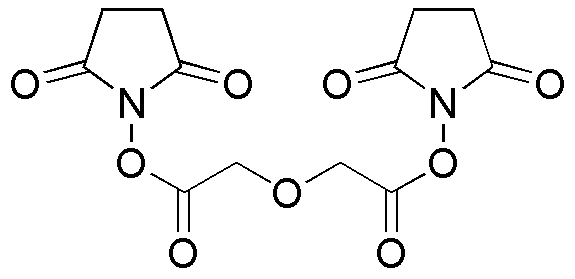Bis-N-succinimidyl diglycolic acid is widely utilized in research focused on:
- Bioconjugation: This chemical is commonly used to link biomolecules, such as proteins and antibodies, enhancing their functionality for targeted drug delivery systems in pharmaceuticals.
- Diagnostics: It plays a crucial role in the development of diagnostic assays, where it helps in the immobilization of antigens or antibodies on surfaces, improving the sensitivity and specificity of tests.
- Vaccine Development: The compound is utilized in formulating vaccines by facilitating the conjugation of antigens to carrier proteins, which can enhance immune responses.
- Polymer Chemistry: In the field of materials science, it aids in creating cross-linked polymer networks, resulting in materials with desirable mechanical properties for various applications.
- Research Tools: It serves as a valuable tool in molecular biology for labeling and tracking biomolecules, allowing researchers to study cellular processes with greater precision.
General Information
Properties
Safety and Regulations
Applications
Bis-N-succinimidyl diglycolic acid is widely utilized in research focused on:
- Bioconjugation: This chemical is commonly used to link biomolecules, such as proteins and antibodies, enhancing their functionality for targeted drug delivery systems in pharmaceuticals.
- Diagnostics: It plays a crucial role in the development of diagnostic assays, where it helps in the immobilization of antigens or antibodies on surfaces, improving the sensitivity and specificity of tests.
- Vaccine Development: The compound is utilized in formulating vaccines by facilitating the conjugation of antigens to carrier proteins, which can enhance immune responses.
- Polymer Chemistry: In the field of materials science, it aids in creating cross-linked polymer networks, resulting in materials with desirable mechanical properties for various applications.
- Research Tools: It serves as a valuable tool in molecular biology for labeling and tracking biomolecules, allowing researchers to study cellular processes with greater precision.
Documents
Safety Data Sheets (SDS)
The SDS provides comprehensive safety information on handling, storage, and disposal of the product.
Product Specification (PS)
The PS provides a comprehensive breakdown of the product’s properties, including chemical composition, physical state, purity, and storage requirements. It also details acceptable quality ranges and the product's intended applications.
Certificates of Analysis (COA)
Search for Certificates of Analysis (COA) by entering the products Lot Number. Lot and Batch Numbers can be found on a product’s label following the words ‘Lot’ or ‘Batch’.
*Catalog Number
*Lot Number
Certificates Of Origin (COO)
This COO confirms the country where the product was manufactured, and also details the materials and components used in it and whether it is derived from natural, synthetic, or other specific sources. This certificate may be required for customs, trade, and regulatory compliance.
*Catalog Number
*Lot Number
Safety Data Sheets (SDS)
The SDS provides comprehensive safety information on handling, storage, and disposal of the product.
DownloadProduct Specification (PS)
The PS provides a comprehensive breakdown of the product’s properties, including chemical composition, physical state, purity, and storage requirements. It also details acceptable quality ranges and the product's intended applications.
DownloadCertificates of Analysis (COA)
Search for Certificates of Analysis (COA) by entering the products Lot Number. Lot and Batch Numbers can be found on a product’s label following the words ‘Lot’ or ‘Batch’.
*Catalog Number
*Lot Number
Certificates Of Origin (COO)
This COO confirms the country where the product was manufactured, and also details the materials and components used in it and whether it is derived from natural, synthetic, or other specific sources. This certificate may be required for customs, trade, and regulatory compliance.


